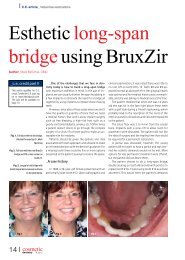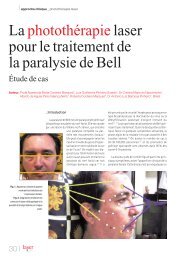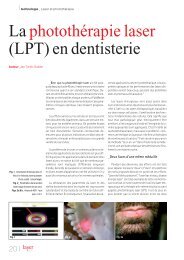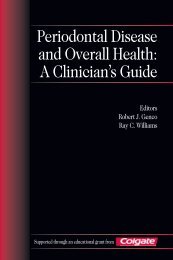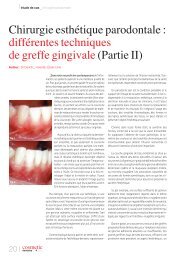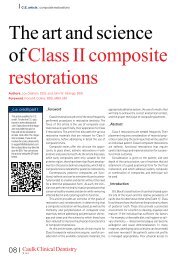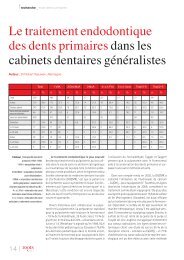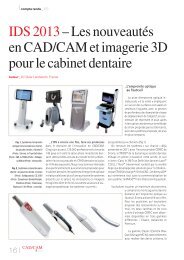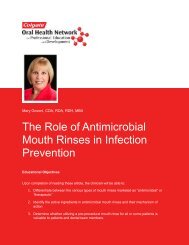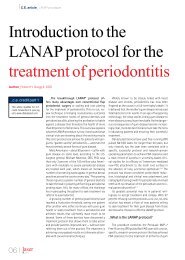Periodontal Disease and Overall Health: A Clinician's Guide
Periodontal Disease and Overall Health: A Clinician's Guide
Periodontal Disease and Overall Health: A Clinician's Guide
You also want an ePaper? Increase the reach of your titles
YUMPU automatically turns print PDFs into web optimized ePapers that Google loves.
CHAPTER 2 Overview of <strong>Periodontal</strong> <strong>Disease</strong>:CHAPTER 2 Causes, Pathogenesis, <strong>and</strong> Characteristics 11Risk FactorsThere are a number of risk factors associatedwith periodontal diseases. 29-34 Determiningrisk is helpful in developing recommendationsfor prevention <strong>and</strong> indetermining strategies for the overall managementof periodontitis. It has been recognizedthat the severity <strong>and</strong> progression ofperiodontal disease varies from individualto individual. Bacteria are essential for theinitiation of the disease, but it is the host responseto the bacterial challenge that determinesthe severity <strong>and</strong> rate of progression ofthe periodontitis. Therefore, it is the host’simmunologic reaction that determines susceptibilityto the disease.General categories of risk factors associatedwith the development of periodontitisinclude genetic, environmental (e.g., tobaccouse), <strong>and</strong> acquired risk factors (e.g., systemicdisease). Risk factors (Table 2) <strong>and</strong> riskreduction strategies (Table 3) should be consideredwhen assessing each patient. 35 Somerisk factors can be modified to reduce apatient’s susceptibility. Environmental factorssuch as tobacco use <strong>and</strong> stress can bemanaged with smoking cessation <strong>and</strong> stressmanagement; for acquired factors such assystemic diseases, medications usuallyprescribed by the physician can be used tohelp in the management <strong>and</strong> control ofchronic disorders (Table 3). The use ofchemotherapeutic agents specifically designedto improve the clinical outcomes ofmechanical treatments for periodontal diseasesmay be particularly useful in the managementof those individuals with single ormultiple risk factors. Risk assessment canTable 2. Risk Assessment for Periodontitis1. Heredity as determined by genetic testing <strong>and</strong> family history2. Smoking, including frequency, current use, <strong>and</strong> history3. Hormonal variations such as those seen in:a. Pregnancy, in which there are increased levels of estradiol <strong>and</strong> progesterone that may change theenvironment <strong>and</strong> permit virulent organisms to become more destructiveb. Menopause, in which the reduction in estrogen levels leads to osteopenia <strong>and</strong> eventually osteoporosis4. Systemic diseases such as:a. Diabetes (the duration <strong>and</strong> level of control are important)b. Osteoporosisc. Immune system disorders such as HIVd. Hematologic disorders such as neutropeniase. Connective tissue disorders such as Marfan’s <strong>and</strong> Ehlers-Danlos syndromes5. Stress as reported by the patient6. Nutritional deficiencies <strong>and</strong> obesity that may require a dietary analysis7. Medications such as:a. Calcium channel blockersb. Immunomodulatory agentsc. Anticonvulsantsd. Those known to cause dry mouth or xerostomia8. Faulty dentistry such as overhangs <strong>and</strong> subgingival margins9. Poor oral hygiene resulting in excessive plaque <strong>and</strong> calculus10. History of periodontal diseaseSources: J Periodontol 1994;65:260–267. 29 J Periodontol 1995;66:23–29. 30 J Periodontol 1999;70:711–723. 31J Periodontol 2000;71:1057–1066. 32 J Periodontol 2000;71:1215–1223. 33 J Periodontol 2000;71:1492–1498. 34



